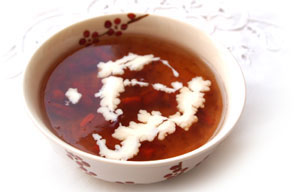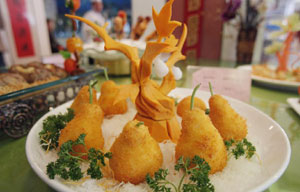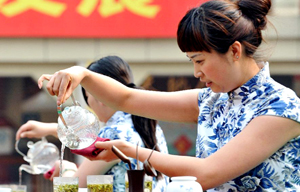
 |
|
Wang Xingyun, the chef at Guixi restaurant in Guiyang, China, preparing gong bao chicken.[Photo/The New York Times] |
In smoke-filled private rooms, boisterous men vie to best each other in downing shots of fiery mao-tai, the rice liquor that is this city's most famous product. In the big open dining room, filled with large round tables where extended families gather, including beaming nanas and cavorting children, there is scarcely an empty seat in the house.
What brings many diners to this restaurant is its famous gong bao jiding, a dish whose perfume wafts through the air, distinctive even over the smell of tobacco smoke.
As it is spoken here, the name of the recipe, one of China's best-known chicken dishes, would mean little to most Americans. Yet it or something very much inspired by it - kung pao chicken - is one of the most commonly ordered items in Chinese restaurants across the United States.
|
|
|
Wang Xingyun said versions of gong bao chicken made with peanuts are not authentic.[Photos/The New York Times] |
Informed for the first time that something called kung pao chicken is widely eaten in the United States, the restaurant's veteran chef, Wang Xingyun, who was dressed in a white smock, dingy from hours of work with cleaver and wok, expressed his skepticism with the lifting of one weary eyebrow.
"Whatever they are eating there is certainly not authentic," he said.
Of course Mr. Wang, a stickler for ingredients and for technique who has been preparing meals built around the dish for over 30 years, says much the same even about what passes for kung pao chicken in Sichuan, the province right next door, where it is almost equally popular and where the dish began its journey across the ocean to America. "Nowadays it's a mess," Chef Wang announced, leading a visitor on a tour of his busy kitchen. '"Everyone says they can make our food, but they don't even understand its origins."
Zhang Tao, the publisher of Z-Survey, a popular series of guidebooks for restaurants in China, said that confusion about technique and the mangling of dishes can travel both ways, as can even an occasional improvement on the original.
"If an Italian went to an Italian restaurant in Chengdu, I don't think his expectations would be so high," said Mr. Zhang, who attended DePauw University in Indiana.
 |
|
Wang Xingyun's customers.[Photos/The New York Times] |
Dicing ginger and chives on a cutting board, then heating his wok on a stove whose intense, shooting flames looked like a furnace blast, Mr. Wang demonstrated what he insisted was the genuine item.
The master chef repeatedly placed a heap of chopped chicken into the wok ever so briefly, only to remove it, adding a new seasoning and repeating the process. The technique is a subtle cooking by accretion, whose theatrics, built around quick handiwork with the wok, is a hallmark of an authentic Chinese kitchen.
"Gong bao jiding demands very particular materials," he said. "Sichuan chefs use the chicken breast, which is wrong. The real thing must have the leg meat of young chickens." Chest meat, he asserted, is too stringy, whereas the drumstick of a young chicken is "delicate and easy to chew."
The demonstration continued with a similar disquisition on peppers, which, once again, Mr. Wang said, Sichuan's more famous chefs, who use dry pepper, get all wrong. "It must be fresh zi ba pepper, and it must be from Huaxi district in Guiyang, which ensures that it is spicy and has a good aroma," he specified.
Finally, he came to the light, brownish sauce. "Sichuan chefs use a bean sauce, but we use a sweet sauce, and that's a big difference," Mr. Wang said. "After the leg meat is chopped, a little fermented rice soup should be added. Authentic gong bao jiding should carry a little aroma of litchi. A little sweetness is a must."
That cooks in the next province can get a relatively simple dish so wrong, according to one of Guiyang's best chefs, provides an instructive hint of just how far American versions of this dish, and many others, may have strayed from their origins. The commonly accepted story here is that gong bao jiding was named for a palace guard, or "gong bao," in the late 19th century, who went on to become a provincial governor.
"Last but not least, authentic gong bao jiding should have absolutely no peanuts," Mr. Wang said sternly. Unlike Sichuan or American versions, the dish was indeed peanut-free. "One must not be even slightly careless in the choice of materials," the chef added.
Of course, they forgot to tell the cooks in Sichuan that. "We were not even taught to add peanuts, as it's so natural to do so," said Li Wanming, a Sichuan chef who is vice president of a food company in Chengdu, the provincial capital. "People who order the dish would feel strange if there's no peanuts in it. Peanuts make the dish more crisp and fragrant, and that's very important."

2013 Chinese New Year |

Hidden dragons, crouching tigers |

Soap beans, silver ears and peach gum |

Special:Winter Solstice |

'Potato festival' kicks off in Shandong |

Mario themed restaurant opens in Tianjin |

HK carries out avian influenza tests on imported chicken |

2013 China Tea Conference kicks off in Zhejiang |